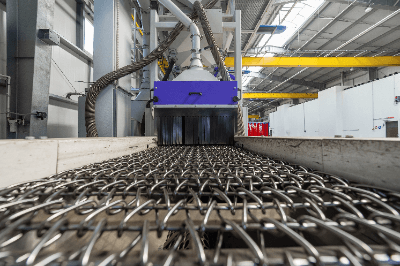What Is a Net Conveyor?

Net Conveyor is a conveyor that transports items.
It is constructed using conveyor belts and rollers to move goods at a constant speed and direction. Net Conveyor enables labor savings, mass production, and product uniformity in heat treatment, drying, freezing, heating, sterilization, washing, dehydration, and conveying, especially in the food manufacturing process.
Wire mesh nets with heat and corrosion resistance are widely used for these nets. Net Conveyor can streamline the production process and reduce costs.
Uses of Net Conveyors
Net Conveyors are used in a wide range of applications in many industries due to their high degree of automation and efficiency. These systems effectively improve the process of moving and transporting goods, increasing productivity and optimizing work efficiency.
The materials to be transported range from light to heavy, cool to hot, and chemical resistant.
1. Manufacturing Industry
Net Conveyors play an important role in production lines and assembly processes. By automatically conveying parts and products, they reduce the burden on workers and improve the speed and accuracy of assembly operations.
In addition, products move at a uniform speed, ensuring consistent quality. Net Conveyors are also used for in-plant logistics and material supply to ensure smooth production flow.
2. Manufacturing Industry
Net Conveyors also play a major role in the logistics industry. By automating the transportation and sorting of goods in warehouses, net conveyors ensure efficient inventory control and quick shipments.
Large Net Conveyors are also used at ports, airports, and other cargo handling locations to efficiently move and unload containers and pallets. This improves the efficiency of the entire transportation process and enhances the competitiveness of the logistics industry.
3. Food Industry
Some Net Conveyors can be used to transport scallops and wakame seaweed, which can be boiled during transport. Conversely, if conveying while running cooling water, the target product can be conveyed while keeping it cool.
In addition to food processing, conveyors are also used for washing and drying processes, cooling of castings and forgings, and conveying in heat treatment lines.
Principle of Net Conveyors
Net Conveyors are usually equipped with a motor or engine as the drive unit. This drive unit rotates the conveyor belt to transport the goods.
The speed and direction of the belt is regulated by a control unit, making conveying suitable for different applications. Net Conveyors have different characteristics depending on the type.
1. S-Type Sectional Belt
This is the simplest structure of Net Conveyor and is commonly used as a fence.
While it is inexpensive, its disadvantage is that it has low tensile strength and is prone to meandering due to easy distortion of the net. It is advisable to use a method of connecting alternating left- and right-handed lathsens at regular intervals by means of force-bonds (horizontal lines), or by setting chains.
2. Type B Balance Belt
The product known as the “B” balance belt is the most versatile and excellent for a wide range of applications. It is made of alternating left- and right-handed spirals connected by crimped force-bonds, which provide a balanced response to stress. It is resistant to meandering during operation and has high tensile strength, making it suitable for a wide range of applications.
3. Type G Glass-Tec Belt
G-type Glass-Tec Belts are similar in construction to B-type belts. It has a smaller helix pitch and uses thicker wire, which gives it superior tensile strength and is used for heat treatment and other applications.
4. RR Type Rod Reinforced Belt
RR-type Rod Reinforced Belts are structurally very high in tension, resulting in less net elongation, making this type especially suitable for high-temperature applications. Usually, the helix and the force bone are often on the same path, allowing for force bone and flange processing.
Features of Net Conveyor
To withstand the wear and load that occurs during the transport of goods, the conveyor belt and drive unit are made of sturdy materials. This ensures stable operation over long periods of use and reduces the need for maintenance.
The width, length, and height of the belt are adjustable and can be customized to meet specific work environments, making it suitable for a wide variety of needs.